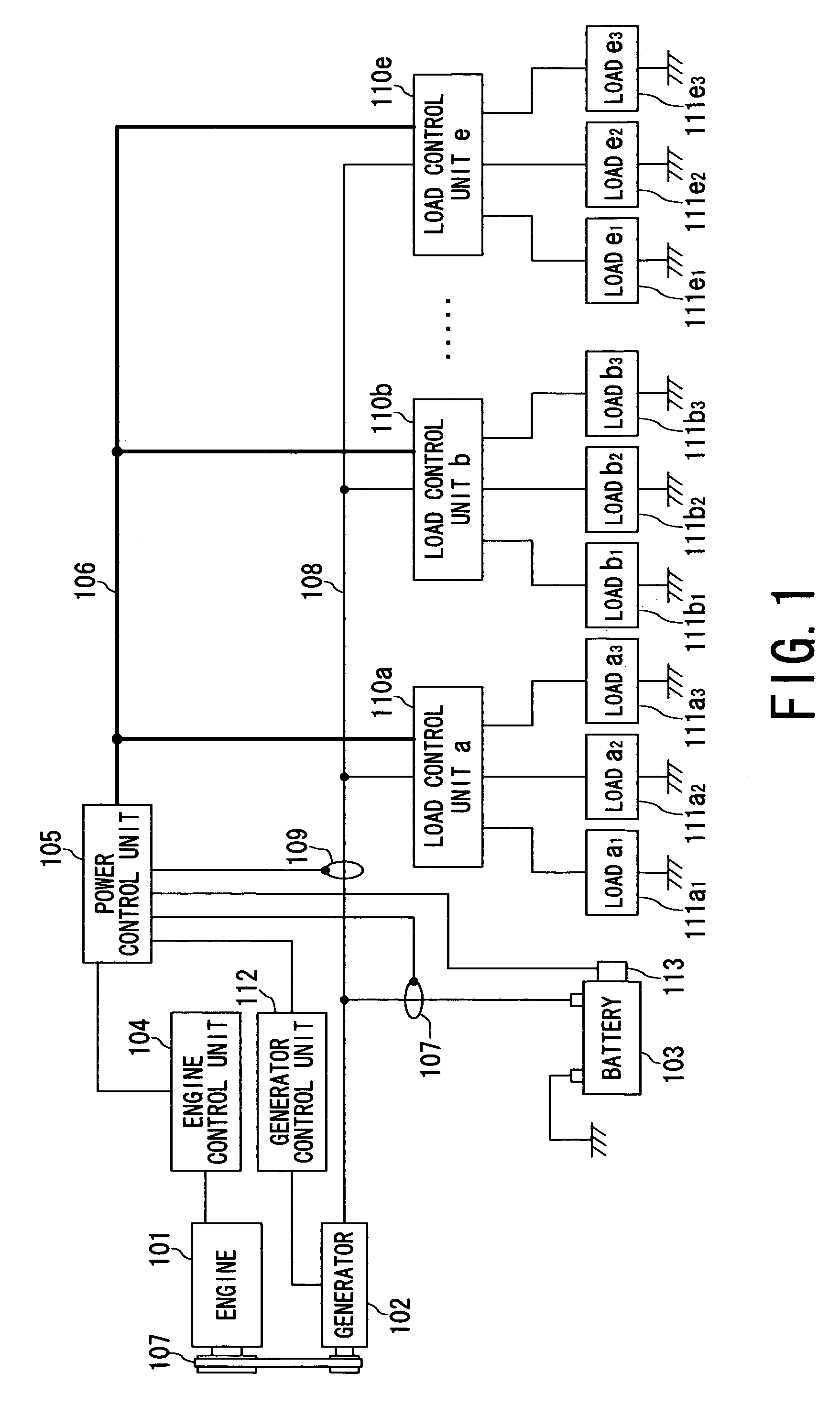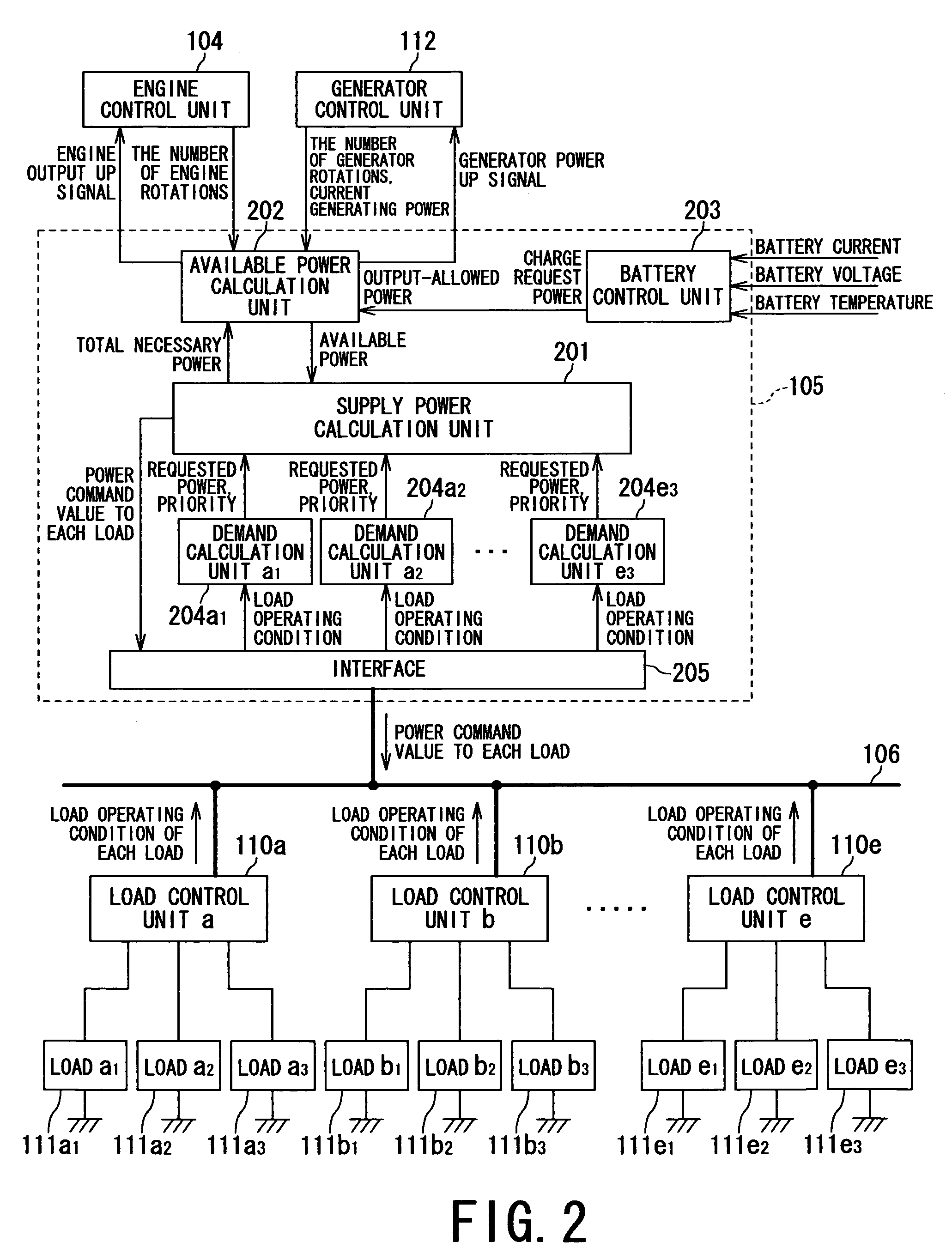Method and apparatus for driving and controlling on-vehicle loads
a technology for driving and controlling electrical on-vehicle loads, applied in the direction of ac network voltage adjustment, electric devices, transportation and packaging, etc., can solve the problems of increasing the total power consumption remarkably, affecting the operation performance of the vehicle, and limiting the amount of power available, so as to reduce the undesirable influence and reduce the operation performance of the remaining loads.
- Summary
- Abstract
- Description
- Claims
- Application Information
AI Technical Summary
Benefits of technology
Problems solved by technology
Method used
Image
Examples
first embodiment
[0064](First Embodiment)
[0065]An on-vehicle load driving and controlling system according to a first embodiment of the present invention will now be described.
[0066]FIG. 1 is a block diagram showing a power supply system mounted on a vehicle, in which the power supply system is provided with the on-vehicle load driving and controlling system according to the first embodiment.
[0067]First of all, the configuration of the power supply system is provided with an engine 101, generator 102, battery 103, engine control unit 104, power control unit 105, load control units 110a to 110e, and generator control unit 112. The generator 102 is coupled with the engine 101 via a belt 107, and coupled with both of the battery 103 and the load control units 110a to 110e via a power supply line 108.
[0068]Each of the load control units 110a to 110e is in charge of controlling supply of power (electric power) to each group of loads 111a1 to 111a3 (to 111e1 to 111e3). Each of the load control units 110a ...
second embodiment
[0151](Second Embodiment)
[0152]Referring to FIG. 17, a second embodiment of the present invention will now be described. The present embodiment relates to another example of the routine for calculating the priority. FIG. 17 shows a subroutine for such calculation. FIG. 17 corresponds to FIG. 8 in the first embodiment, in which steps S1601 to S1604 are the same as the steps in FIG. 8.
[0153]The subroutine shown in FIG. 17 is different from that in FIG. 8 in that steps S1605, S1606 and S1607 are added. To be specific, after calculating the priority in the normal operation, it is determined at step S1605 whether or not a power command value to each load is less than an amount of necessary power of the load. If the determination is YES (the power command value is less than the necessary power amount), the processing is then executed at step S1606. At this step S1606, it is further determined whether or not the calculated priority at step S1602 is still less than a predetermined priority ...
third embodiment
[0155](Third Embodiment)
[0156]Referring to FIGS. 18 and 19, a third embodiment of the present invention will now be described. The present embodiment relates to another example of the routine for calculating the priority. FIG. 18 shows a subroutine for such calculation. FIG. 18 corresponds to FIG. 8 in the first embodiment, in which steps S1701 to S1704 are the same as the steps in FIG. 8.
[0157]The subroutine shown in FIG. 18 is different from that in FIG. 8 in that steps S1705 to S1709 are added. To be specific, after calculating the priority in the normal operation, it is determined at step S1705 whether or not a power command value (i.e., power to be supplied) to each load is less than an amount of necessary power of the load. If determined YES at step S1705 (i.e, the power command value is less than the necessary power amount), the processing goes to step S1706, at which the priority is within a predetermined range inherent to the load. If YES at step S1706 (i.e., the priority i...
PUM
 Login to View More
Login to View More Abstract
Description
Claims
Application Information
 Login to View More
Login to View More - R&D
- Intellectual Property
- Life Sciences
- Materials
- Tech Scout
- Unparalleled Data Quality
- Higher Quality Content
- 60% Fewer Hallucinations
Browse by: Latest US Patents, China's latest patents, Technical Efficacy Thesaurus, Application Domain, Technology Topic, Popular Technical Reports.
© 2025 PatSnap. All rights reserved.Legal|Privacy policy|Modern Slavery Act Transparency Statement|Sitemap|About US| Contact US: help@patsnap.com



